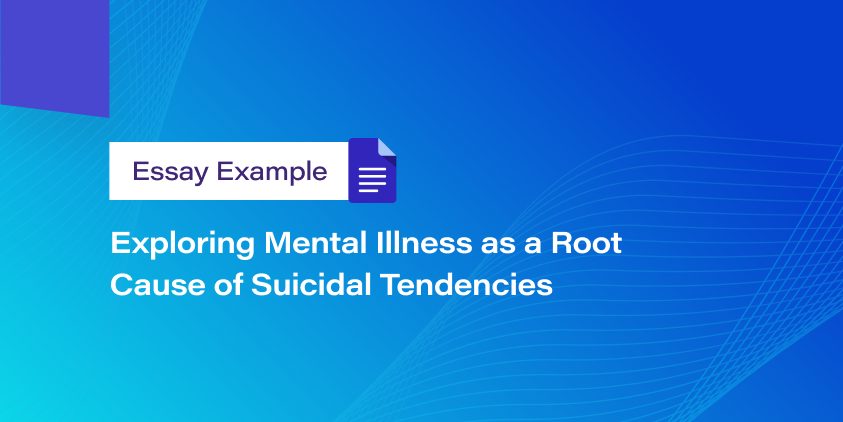Exploring Mental Illness as a Root Cause of Suicidal Tendencies

Mental Illness as the Leading Cause of Suicide
Scientists have continuously reported high mortality risks among individuals suffering from mental disorders. Over the recent decades, more and more evidence has been gathered to support the idea that mental and behavioral disorders can be attributed to the increase in premature mortality rate (Chesney, Goodwin, & Fazel, 2014). In most cases, the death is caused not by the mental illness but by other related factors that emerge from the condition. Any mental disorder places a person at risk of death as they usually imply adverse health behavior like lack of activity, poor diet, and the necessity to take a lot of medicines, all of which contribute to the high rates of various heart and chronic diseases and infections (Reisinger Walker, McGee, & Druss, 2015). Apart from specific health conditions, suicide is one of the leading causes of death among people with various mental conditions, and the main diseases that lead to the act are schizophrenia, clinical depression, and bipolar disorder.
Background Information
To begin with, it is a well-established fact that about 90% of suicides are caused by a mental disorder of some severity (Hjelmeland & Knizek, 2017). This is not always said directly; however, some researchers underline this connection and claim that almost all suicides result from mental conditions. This statement is based on numerous practice-based evidence and is widely discussed in the specific literature, media and suicide prevention work. The statistics and conclusions result from the psychological autopsy studies conducted by engaging the patients’ relatives to establish a diagnosis. Some scientists question this methodology as they believe it is impossible to make valid assumptions about someone’s psychological state relying on other people’s words (Hjelmeland & Knizek, 2017). Nevertheless, the link between mental illness and one’s decision to commit suicide cannot be fully disregarded.
Depression as the Cause of Suicides
Depression is claimed to account for the major part of suicides caused by mental disorders. The main characteristics of the condition include long periods of deep desperation and sadness (University of California Santa Cruz, n.d.). People who suffer from this disorder often cannot cope with it themselves and require the specialist’s help. The most common signs of depression are frequent mood swings, lack of energy and problems with concentration, insomnia, loss of appetite, and feelings of excess guilt and worthlessness (University of California Santa Cruz, n.d.). Despite being classified as a mental disorder, depression has a biological basis, too. The research suggests that the feelings experienced by the depressed person are caused by hormone imbalance, namely changes in the activity of neurotransmitters like serotonin and norepinephrine (University of California Santa Cruz, n.d.). In such a case, antidepressant therapy works by changing the level of hormones chemically and, thus, balancing the emotional state so that the person does not experience the tiresome mood swings anymore. Quite often, depression may occur due to some social factors. For instance, loss or disappointment can trigger psychological condition that makes a person more vulnerable to mental illness (University of California Santa Cruz, n.d.). People suffering from depression need help and support from their friends and relatives, which is significant in overcoming the condition and returning to normal life. Combining social support with appropriate medicament treatment results in full recovery.
However, suppose a person does not get the required help. In that case, there is a risk of developing the idea that suicide is the permanent solution to the suffering connected with experiencing painful emotions. Suicidal thoughts may differ, like planning a way to die, reading about different approaches to commit suicide, or even preparing for the act. Sometimes, if a depressed person demonstrates a sudden uplift, this might signify the decision to kill oneself (University of California Santa Cruz, n.d.). In most cases, it is possible to stop an individual from taking their own life. People who have been prevented from committing suicide are glad they did not die, which implies that most of those who have died could have been helped. The assistance of friends or professionals in fighting this mental disorder reduces the risk of suicide if provided timely and if the condition is taken seriously. To decrease the level of suicides caused by depression, specific preventive measures have been developed. For instance, psychotherapy and cognitive behavior therapy are the most commonly applied (University of California Santa Cruz, n.d.).
Moreover, increased awareness among medical specialists plays an important role in suicide prevention, too. Often, patients seek medical advice, but professionals miss the suicidal signs (University of California Santa Cruz, n. d.). Therefore, even though depression is one of the most common reasons for suicides, if one pays attention to the signs demonstrated by the depressed individual and properly reacts, the act can be stopped and prevented.
Bipolar Disorder as the Cause of Suicides
Bipolar disorder is another medical condition that is likely to cause suicide. It is also known as manic depression or manic-depressive disorder (Smith & Segal, 2018). It is mainly characterized by severe mood swings, unexpected behavior and energy level fluctuations (Smith & Segal, 2018). The mood changes are quite intense, and, as a rule, they seriously interfere with everyday life and affect the ability to function properly. The maniac and depressive episodes change each other and can last for quite long, from a couple of days to months (Smith & Segal, 2018). Various external or psychological factors can trigger them; nevertheless, this is not necessarily a rule. The reasons for the development of bipolar disorder have not been understood yet. However, it often happens to people with a family history of the condition. The first signs of the disorder usually develop in the teenage period or early twenties and include either manic or depressive episodes (Smith & Segal, 2018). The condition can be overlooked because the symptoms are quite confusing and might be misinterpreted. Yet, in case of timely diagnosis and appropriate treatment, the person with bipolar disorder can function normally.
Concerning bipolar disorder, the risk of suicide is especially high during the depressive phase of the condition. Furthermore, if compared to depression, more attempts tend to be lethal. The basic suicide warning signs include talking about death or self-harm experiencing helplessness or worthlessness (Smith & Segal, 2018). Overall, timely recognition of symptoms and proper counseling help prevent suicide in individuals experiencing bipolar disorder, and further development of social connections with other people can avert suicidal attempts in the future.
Schizophrenia as the Cause of Suicides
Suicide is a major risk factor for people who have schizophrenia as well. Such cases are especially difficult to notice and prevent as a suicidal act can happen impulsively without any prior signs. Studies indicate that chances to commit suicide are higher in severe and chronic cases of disorder with more frequent psychiatric hospitalizations (Pompili et al., 2007). It is also worth mentioning that the ratio of men to women who have schizophrenia with the suicidal outcome is 3:2 (Pompili et al., 2007). The risk of suicidal outcomes is likely to increase if the person has a history of alcohol and substance abuse or developed depression after being diagnosed with schizophrenia. Other factors leading to lethal outcomes are unemployment, social isolation and loneliness. Self-destructive behavior of individuals with schizophrenia can be explained by progressive mental deterioration resulting from changes in their lives after establishing the diagnosis. In addition, hopelessness and loss of trust in treatment may provoke thoughts about suicide, so this symptom must be watched closely to prevent attempts to take one’s own life.
Furthermore, a family history of suicide impacts the individual’s decision to commit one. It has been proven that cases of suicide in the family significantly increase the risk of the act. To fight the issue, specific clinical practice guidelines exist with the outline for assessing and treating patients with suicidal behaviors suffering from schizophrenia (Pompili et al., 2007). Therefore, the major tactics for preventing suicidal attempts are based on identifying the risk factors and close observation of the patient.
Conclusion
The connection between various mental disorders like clinical depression, bipolar disorder and schizophrenia is a proven fact. Numerous studies have confirmed this through conducting psychological autopsy and assessing clinical cases of the disorders. Each of the mental illnesses described may lead to suicidal attempts due to negative emotions and painful feelings experienced due to the chemical imbalance caused by it. Numerous additional factors also result in suicidal behavior development, like alcohol and substance abuse or a family history of suicide. All of the factors are to be considered, as in some cases, the attempts to commit suicide can be quite impulsive and practically impossible to predict. In such situations, close assessment and questioning of the patient are the only ways to assess the risk. Undoubtedly, timely identification of suicidal intentions is key to preventing lethal outcomes. However, it may be difficult as most symptoms are dubious and confusing and, thus, might be easily misinterpreted. People suffering from various mental disorders usually have difficulty managing their conditions by themselves, and they require help and support from their families and friends, along with proper specialist counseling. If required, psychotherapy combined with medicament treatment is also a good approach to treating the disorders. The counseling sessions turn out to be especially helpful if the doctors are specially educated and aware of all the signs of mental disorders so that they are capable of recognizing the risk of suicidal behavior and successfully preventing it.
📎 References:
1. Chesney, E., Goodwyn, G. M., & Fazel, S. (2014). Risks of all-cause and suicide mortality in mental disorders: A meta-review. World Psychiatry, 13(2), 153–160.
2. Hjelmeland, H., & Knizek, B. L. (2017). Suicide and mental disorders: A discourse of politics, power, and vested interests. Death Studies, 41(8), 481-492. https://doi.org/10.1080/07481187.2017.1332905
3. Pompili, M., Amador, X. F., Girardi, P., Harkavy-Friendman, J., Harrow, M., Kaplan, K., … Tatarelli, R. (2007). Suicide risk in schizophrenia: Learning from the past to change the future. Annals of General Psychiatry, 6(1), 10. https://doi.org/10.1186/1744-859X-6-10
4. Reisinger Walker, E., McGee, R. E., & Druss B. G. (2015). Mortality in mental disorders and global disease burden implications. A systematic review and meta-analysis. JAMA Psychiatry, 72(4), 334-341. https://doi.org/10.1001/jamapsychiatry.2014.2502.
5. Smith, M. & Segal, J. (2018). Bipolar disorder signs and symptoms. Retrieved from https://www.helpguide.org/articles/bipolar-disorder/bipolar-disorder-signs-and-symptoms.htm
6. University of California Santa Cruz. (n. d.). Depression and suicide.
